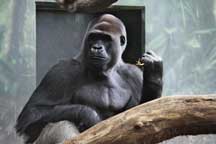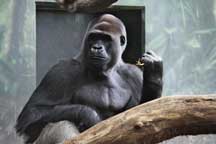 KINGSTON, R.I. – January 21, 2014 — Humans and other primates mature very slowly and have long life spans compared to most other mammals, and it has long been believed that the reason for this slow growth is that primates allocate more of their energy resources to the development of their large brains.
KINGSTON, R.I. – January 21, 2014 — Humans and other primates mature very slowly and have long life spans compared to most other mammals, and it has long been believed that the reason for this slow growth is that primates allocate more of their energy resources to the development of their large brains.
But an international team of researchers from more than a dozen universities, including a University of Rhode Island anthropologist, has discovered an alternative explanation: primates expend much less energy every day.
By calculating the total daily energy expenditure of gorillas, chimpanzees, humans, orangutans, lemurs and other primates, the researchers found that primates in zoos, sanctuaries and in the wild burn 50 percent fewer calories than other mammals of similar size. This dramatically reduced metabolic rate accounts for primates’ slow pace of life.
The research was published January 13 in the Proceedings of the National Academies of Science.
“Primates must be using energy differently than other mammals do,” said Holly Dunsworth, URI associate professor of anthropology. “We can’t explain it yet, but the way we process energy is different. Maybe we have a different biological clock that slows down our energy use.”
Dunsworth said the results might seem counterintuitive because “we might assume that large-brained, intelligent mammals like primates would use more energy, not less.”
The researchers, led by Herman Pontzer of Hunter College, found that the differences in energy expenditure cannot be explained by differences in each animal’s activity levels. To burn as many calories as non-primate mammals, a human would have to walk an extra 45 kilometers per day, and a lemur would have to add 89 kilometers per day to its daily foraging activity.
To collect data for the study, Dunsworth studied the behavior of captive gorillas and chimpanzees at the Lincoln Park Zoo in Chicago in 2010 and 2011. She also used the doubly-labeled water technique, in which a harmless cocktail of water made of uncommon isotopes was ingested by each ape and, over the course of several days, urine was collected and analyzed to measure calories burned per day. Others on the research team collected similar data on other primates.
When comparing data from wild and captive animals, the researchers were surprised to find that many primates are as active in captivity as they are in the wild, and yet they burn a similar number of calories.
“Gorillas may even be more sedentary in the wild than at the Lincoln Park Zoo, but they still use the same amount of energy per day,” Dunsworth said. “Relatively sedentary humans also burn about the same number of calories as those who actively forage for their food. It’s more evidence that activity levels don’t explain our results. It also speaks volumes about the value of excellently-managed zoos like Lincoln Park, both for science and conservation.”
The study’s findings have implications for understanding the health and longevity of humans. Linking daily energy expenditure to the rate of growth, reproduction and aging may shed light on the processes by which humans develop and age. And unraveling the complex relationship between physical activity and energy expenditure may improve our understanding of metabolic diseases.
Dunsworth is a biological anthropologist who studies living apes and fossils of apes to learn about primate evolution and how mammals process energy. She has recently won acclaim for her studies of the factors that determine human gestation, finding that the length of human pregnancy is limited primarily by a mother’s metabolism, not the size of the birth canal.
“The results of this latest study make me wonder what we could learn if we had this same sort of energy expenditure data for pregnant and lactating primates and their young,” Dunsworth said. “It might help to explain the differences in the reproductive rates and gestation lengths among primates and among other mammals.”

